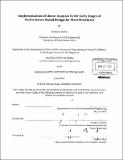Implementation of linear analysis in the early stages of performance-based design for steel structures
Author(s)
Ayala, Antonio (Antonio Ronaldo Puno)
DownloadFull printable version (5.589Mb)
Other Contributors
Massachusetts Institute of Technology. Dept. of Civil and Environmental Engineering.
Advisor
Jerome J. Connor.
Terms of use
Metadata
Show full item recordAbstract
In the aftermath of the destructive 1994 Northridge Earthquake in Southern California, the earthquake engineering industry experienced a shift towards expanding seismic requirements beyond surviving global collapse to include performance criteria. As a part of this effort, the Pacific Earthquake Engineering Research Center has developed a performance-based earthquake engineering (PBEE) procedure that outputs relevant non-technical data to aid major building stakeholders in making important decisions. While PBEE has made great strides in the last decade, its current standing as a verification tool has prevented it from being fully adopted by the seismic design industry. In order for PBEE to be fully integrated into the seismic design process, a method that circumvents the problems associated with the preferred method of nonlinear analysis must be developed. The following study compares interstory drift results from linear and nonlinear analysis to gain insight into their relationship and determine conditions for which linear analysis is an appropriate substitute, yielding a much faster and computationally cheaper procedure. It is hoped that this study will contribute to the adoption of linear analysis in the early seismic design stages, allowing for an optimal structural system selection procedure that integrates performance metrics from the beginning.
Description
Thesis (M. Eng.)--Massachusetts Institute of Technology, Dept. of Civil and Environmental Engineering, 2012. Cataloged from PDF version of thesis. Includes bibliographical references (p. 38-39).
Date issued
2012Department
Massachusetts Institute of Technology. Department of Civil and Environmental EngineeringPublisher
Massachusetts Institute of Technology
Keywords
Civil and Environmental Engineering.